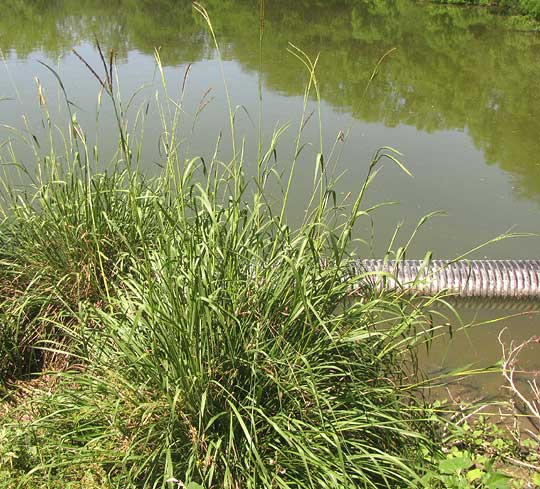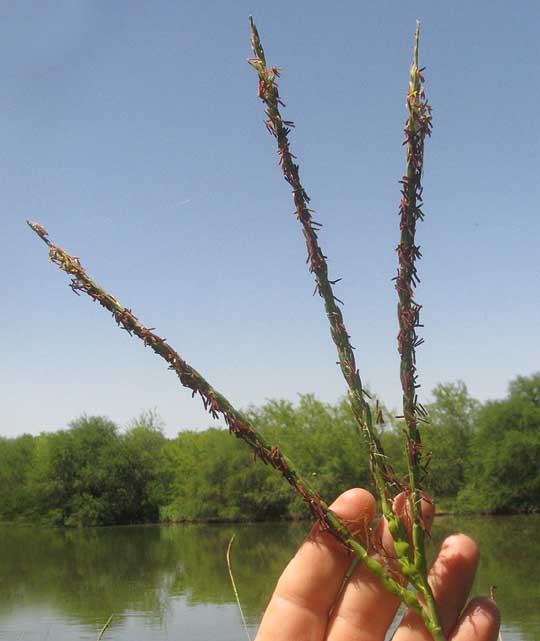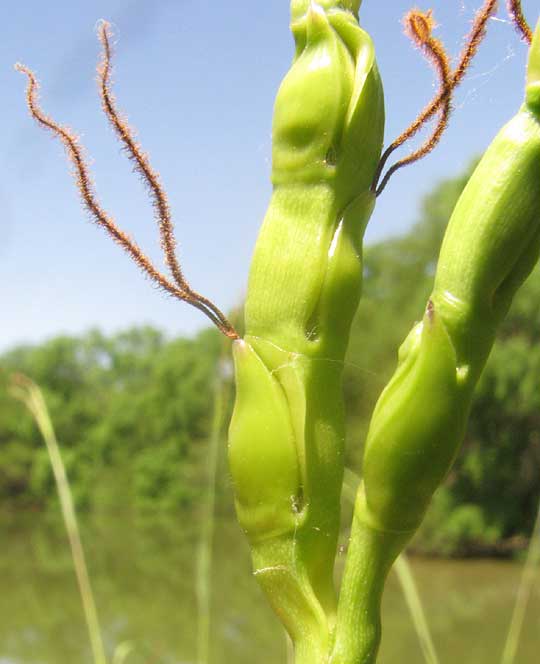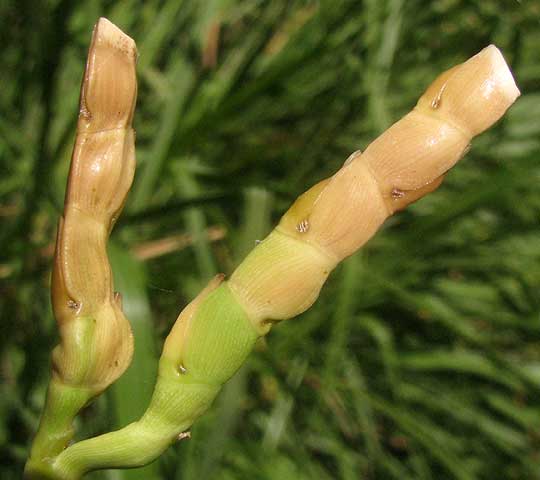Excerpts from Jim Conrad's
Naturalist Newsletter
from the May 4, 2014 Newsletter issued from the Frio Canyon Nature Education Center in the valley of the Dry Frio River in northern Uvalde County, southwestern Texas, on the southern border of the Edwards Plateau; elevation ~1750m (~5750 ft); N29.62°, W99.86°; USA
EASTERN GAMAGRASS
Rooting in mud beside a pond in Cooks Slough Nature Park on Uvalde's south side, nowadays a robust grass is issuing flowering heads on stems about eight ft high (2.5m), as seen below:

The flowering heads, or inflorescences, consist of two or three slender flower spikes, as shown below:

Something interesting to notice in that picture is that each spike's upper 5/6ths or so of length looks different from its lower 1/6th. The lower flowers are green, thick, and lacking the purple trashy things covering the upper part of the spike. Below, you can see what the trashy things are in a closer look at some upper flowers:

Here we can see that the dark, chaffy items messily covering the upper 5/6ths of the spikes are anthers, from which pollen is released in pores that are clearly visible on the ends opposite where the anthers attach to their threadlike filaments. Since the anthers dangle upside-down on their filaments, pollen grains tumble from the anthers' "tops," which hang downward. The picture shows unisexual male flowers. This means that the spike's upper 5/6ths will produce no seedlike grains. Once the male flowers have done their pollinating job, their part of the spike will fall away. Now, below, look at the very different female flowers occupying the spikes' lower regions:

The fuzzy, threadlike things are stigmas designed to catch pollen grains. The tear-shaped items below the stigmas are the female flowers, their ovaries protected beneath hard, shiny, green scales, or glumes. Notice the unusual nature of the "stem," or rachis, to which the individual flowers are attached. Each female flower fits into a hollow indenting the rachis. Since the hollow is deep below and shallow above, the rachis itself narrows where each flower arises, but thickens toward each flower's top, but then quickly thickens again where the next higher flower is affixed. This gives the rachis a zigzag form. When the female flower matures -- when the ovary becomes a grain-type fruit -- the spike breaks immediately below each female flower, and the section of that spike falls away carrying the mature flower with its grain, forming a short, cylindrical, tin-can-looking object people call "seeds," though they're mostly stem and scales. This is a very unusual structure for a grass to produce.
This handsome and amazing grass is TRIPSACUM DACTYLOIDES, native to the warmer parts of the Americas, from the US southeastern and south-central states (as far north as Iowa and New Jersey) south to northern South America. In the US normally it's called Eastern Gamagrass, not to be confused with grama grass, of the genus Bouteloua.
With its unisexual flowers arranged in spikes at the top of the plant, with male flowers above and females below, you might think of another amazing grass, called corn in the US and maize elsewhere. Gamagrass is somewhat related to corn
Eastern Gamagrass is very variable, and its many types have adapted to a wide variety of habitats, from muddy shores like where we found ours, to rocky outcrops and openings in forests. In some places the plant hardly gets knee high but in others it can reach 13ft tall (4m). In South America it's grown for livestock forage but in the US mainly it's grown as an ornamental grass that's easy to grow.
Certain birds eat the grains, and the grass' extensive root system keep soil from washing away.
from the July 20, 2014 Newsletter issued from the Frio Canyon Nature Education Center in the valley of the Dry Frio River in northern Uvalde County, southwestern Texas, on the southern border of the Edwards Plateau; elevation ~1750m (~5750 ft); N29.62°, W99.86°; USA
GAMAGRASS PRODUCING MATURE GRAINS
Nowadays Gamagrass's very unusual-looking and large grains are maturing, as shown below:

Grains break from the spikes' tips, each grain forming a cylindrical, tin-can-like affair with a little eye-like feature at its base. Much of the cylinder is actually part of the stem segment that falls with it, which you can visualize better by looking at pictures showing the rachis on our Gamagrass Page.
Even with this stem material attached, the "seeds" are favorite food for deer and birds. Each plant produces so few seeds that one suspects that the few seeds who do survive to sprout have a good survival rate.